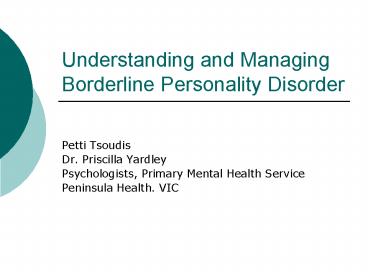Understanding and Managing Borderline Personality Disorder - PowerPoint PPT Presentation
1 / 23
Title:
Understanding and Managing Borderline Personality Disorder
Description:
Doing too much for the client, rescuing. Working Styles. Enmeshed. Withholding ... Attempt to rescue and save. Going beyond the boundaries of the work ... – PowerPoint PPT presentation
Number of Views:101
Avg rating:3.0/5.0
Title: Understanding and Managing Borderline Personality Disorder
1
Understanding and Managing Borderline Personality
Disorder
- Petti Tsoudis
- Dr. Priscilla Yardley
- Psychologists, Primary Mental Health Service
- Peninsula Health. VIC
2
What is Borderline Personality Disorder (BPD)?
3
Diagnostic Statistical Manual for Mental
Disorders (DSM-IV) Criteria for BPD
- Frantic efforts to avoid abandonment
- Uncertainty in the reliability of others leading
to unstable relationships (devaluation/idealisatio
n) - Lack of predictable sense of self or separateness
- Poorly modulated affect
- Poorly modulated impulse control
- Suicidal threats or behaviour, self-harm
- Chronic feelings of emptiness
- Inappropriate anger
- Transient paranoia
4
Background to BPD
- BPD occurs in the context of the development of
an enduring, pervasive, inflexible pattern of
inner experience and behaviour that leads to
distress or impairment.
5
Background to BPD
- Up to 95 have an abuse history (sexual,
physical, emotional abuse) - have background of difficulty with attachments
with others (particularly with early care givers) - History of emotional turbulence (easily
distressed, remain distressed for longer periods,
higher intensity of distress than others) - Leads to feeling overwhelmed in response to even
minor stressors. - Early invalidating environment
6
How does this presentation manifest in clients?
7
How does this presentation manifest in clients?
- Feeling vulnerable, unlovable, HELPLESS
- Strong sense of ABANDONMENT
- Lack of trust
- Self-harm, suicidal behaviours
- SELF HATRED
- Unrealistic expectations, blaming others
- Angry, hostile, demanding, PUNISHING
- Pushing boundaries
- Inconsistency in presentation, CHAOTIC
8
Splitting
- Idealisation vs devaluation
- (e.g. New worker is the best worker, old worker
is worst worker)
9
What feelings are evoked within us when
working with clients with BPD?
10
What feelings are evoked within us when
working with clients with BPD?
- Feel isolated
- Question, doubt ourselves
- Helpless, hopeless, vulnerable
- Feeling unqualified
- Fearful
- Burnt-out, exhausted
- Feeling defensive, angry, resentful
- Withdrawing or shut-down
- Doing too much for the client, rescuing
11
Working Styles
- Enmeshed
- Withholding
- Nurturing/limit setting
12
Enmeshed Style
- Being over-involved
- Attempt to rescue and save
- Going beyond the boundaries of the work
- Aligning with the client against other workers or
services - Solving problems for client
13
Impact of Enmeshed Style
- Reinforces helplessness distress
- Encourages dependency
- Inhibits autonomy and responsibility
- Discourages problem solving
- Not in best interest of client in longer term
14
Withholding Style
- Punitive approach
- Can lead to condescending attitude
- Sarcastic, angry, hostile response
- Judgmental
- Assumes client is creating too many problems for
the worker or service
15
Impact of Withholding Style
- Worker or services withdrawn
- Reinforces invalidating experience
- Can lead clients to escalate their behaviours and
responses to get help (e.g. self-harm attempts,
aggression)
16
Nurturing and Limit Setting Style
- Containment (validation, empathy)
- Compassion
- Constancy
- Consistency
- Calming
- Consequences
17
Impact of Nurturing and Limit-setting Style
- Most constructive response style
- Validates distress
- Recognises peoples ability to learn and change
and enhance existing strengths - Teaching, coaching, assisting and strengthening
people to help themselves - Provision of clear boundaries (appropriate
limit-setting) - Puts order into an emotionally chaotic inner
world
18
Suggestions for Working with this Client Group
19
Strategies for Worker
- Just listen!!
- Identify and validate peoples feelings
- (e.g. It seems youre feeling really
disappointed at the moment) - Take a problem solving approach (ie identify the
current problem, explore possible solutions
together) - Consult, consult, consult
- Refer all suicidal presentations to local
Psychiatric Hospital/Service
20
Strategies for Client
- Distraction (e.g. go for a walk)
- Self-soothing (have a bath)
- Grounding (here and now, name 5 things you can
see, hear and feel) - Mindfulness (Observing breath, sounds, sights)
21
Managing the System
- Be explicit about roles
- Minimise blaming and splitting
- Consult, consult, consult
22
Managing Yourself
- Stress Management
- Seek support
- Debriefing
- Supervision
23
In Summary
- Care, but not too much
- Get close, but dont get enmeshed
- Empathise, but protect your own boundaries
- Hear about trauma, but dont lose optimism
- Witness intense emotion, but maintain focus































